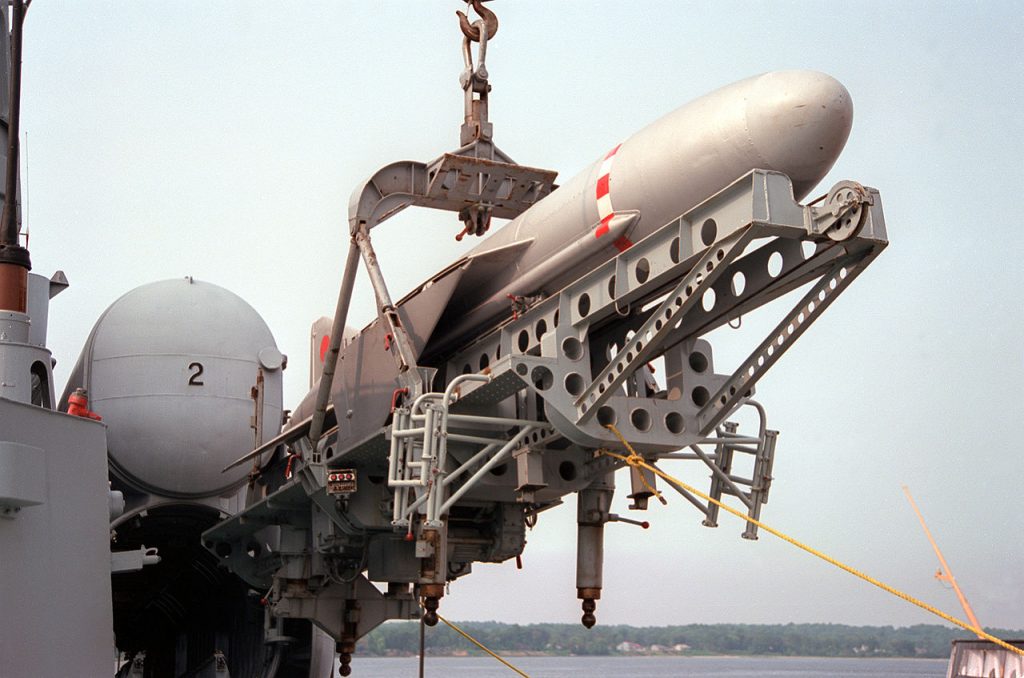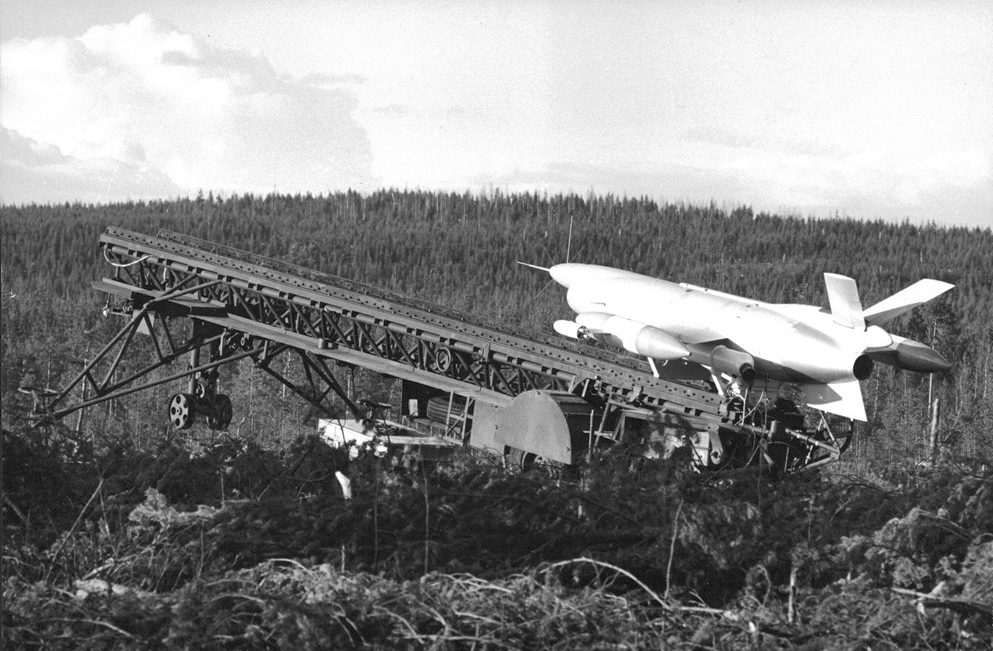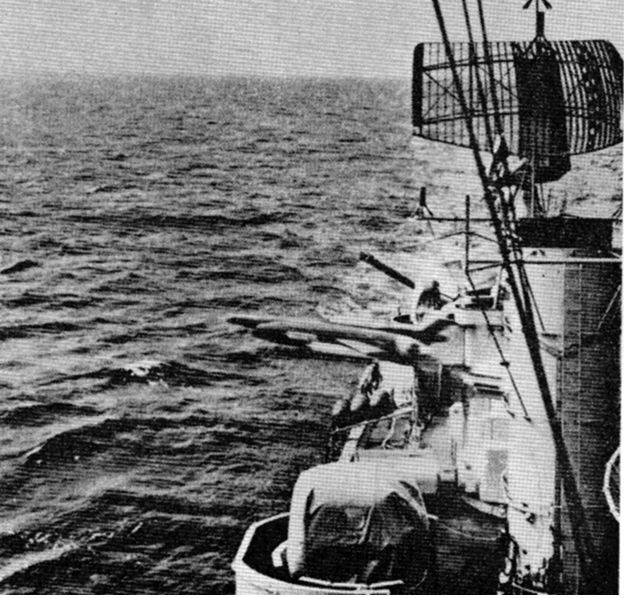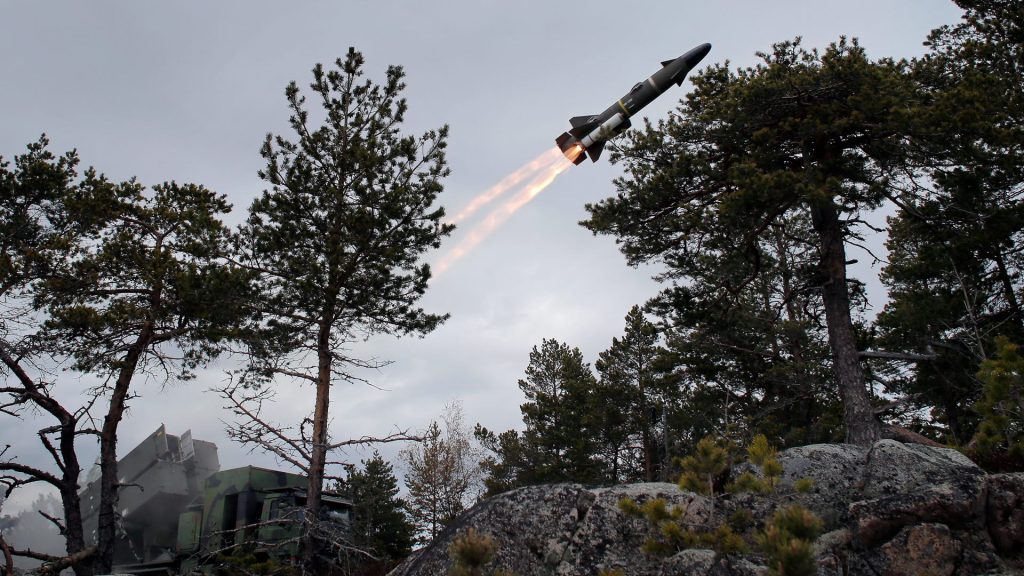The Missile Type RB 08 – A creative redesign
By the end of the 1950s the Swedish Navy had the misfortune of seeing its project of many years development of a Swedish anti-ship missile to be used on both land and sea cancelled in favour of the Swedish Air Force Missile Type 304, which entered service as the Type RB 04. This put the Swedish Navy far behind in respect of having an anti-ship missile. This applied to the whole of the Western world, where the most probable enemy could be the Soviet Union, which already in 1955 had produced and put into service the KS-1 Komet (NATO reporting name ‘Kennel’) large anti-ship missile, quickly followed by the smaller and more flexible P-15 Termit (NATO reporting name ‘Styx’) in 1958. The situation as far as Sweden was concerned was thus precarious.
Anti-ship missiles were still an untested area, but at least in theory they were a weapon with the potential to revolutionise naval warfare, to an even greater extent than their predecessor, the torpedo had done on its introduction. Hence the Navy wanted an anti-ship missile that could also be used by the coastal artillery. However the Missiles Office of The Royal Swedish Air Force Materiel Administration and the Administration itself dumped the Swedish Navy project so it was back to square one, far behind. New ideas took shape, and one that found fertile ground was that it would perhaps be possible to adapt an existing object to suit the Navy’s need.

An East German missile boat loads a P-15 Termit.
The Nord Aviation CT-20 – a drone that became a an anti-ship missile
Military drones are nowadays ten a penny, and are often portrayed as very new and revolutionary. In fact drones have been in use for more than half a century, but it is only now with modern micro technology and miniaturised communications that they have become more nimble and easier to use.
As far back as the Second World War both the Allies and Germany were using remote controlled aircraft. In this case it was older and more nearly obsolete aircraft that were being converted into flying bombs. They were controlled remotely by radio signals from accompanying aircraft, but this was far from the technology built into today’s drones. The idea was to use drone aircraft against targets that were being heavily defended by anti-aircraft artillery. As the accompanying aircraft did not need to fly over the target to drop any bombs, as would be necessary with normal bombers, the risk to this aircraft was not the same as if it was being used for conventional bombing.
However, there were some practical difficulties, because even though the accompanying controlling aircraft didn’t need to fly over the target, it had to be fairly close in order to accurately guide the drone aircraft on to the target. It was therefore under threat from fighter aircraft and anti-aircraft guns that were located further away from the target if the enemy had realised the drone threat existed. The radio signals could also be jammed so that control could be lost.
Nevertheless the idea had taken root, and a useful application for such drones was to act as targets for anti-aircraft fire and fighter aircraft training, and also as a way of safely testing these. In 1957 the French company Nord Aviation brought out its new target missile, or target drone, the CT-20. This was a fairly light design powered by a small jet turbine, which could fly at speeds of up 900 km/h (560 mph). It would be used to help design and test new target-seeking anti-aircraft missiles to be carried on fighter aircraft. Sweden also procured the CT-20.

A CT-20 on its launch ramp at the Vidsel base in Norrbotten, north Sweden. The Vidsel base is a very important testing area for the Swedish Defence Forces.
This led to the idea that an attempt could be made to try to adapt the CT-20 to become a maritime anti-ship missile. This certainly seemed like a realistic project. The CT-20 was basically well tried, which saved a great deal of time. In 1962 The Swedish Navy, in co-operation with Nord Aviation, ordered an anti-ship missile based on the CT-20, from Saab.
Saab had already been involved in an earlier attempt at a Navy anti-ship missile before Missiles Office of The Royal Swedish Air Force Materiel Administration and the Administration itself had taken over all military missile projects. Saab had also acquired great experience in building modern jet aircraft, and since the CT-20 was basically a small unmanned aircraft the step was not so great. In this way, the Navy administration could outmanoeuvre the Aviation administration.
Unlike the Soviet P-15 Termit missile, the forthcoming Missile Type RB 08 was not intended to arm smaller vessels, such as motor torpedo boats. It was the two most modern Swedish Halland class destroyers, HMS Halland and HMS Småland, which would be equipped. Already in the 1950s the Swedish Navy had begun test firing of the Missile Type 315 from these two vessels, so it seems that the plan had always been to initially equip these two destroyers with the new weapon.
The Missile Type 08 was powered by a Turbomeca Marboré II turbojet engine providing 800 lb thrust and was launched from a short ramp with the aid of two powerful solid fuel rockets. After launching, the turbojet took over. The work progressed rapidly and in 1966 HMS Småland was equipped with the first live missiles, and the following year her sister ship HMS Halland also had the new weapon. It had been 10 years since the Missile Administration had scrapped the Missile Type 315 project.
Even though the Swedish Navy’s original missile project had been scrapped, Sweden became in any case the first country in the Western world to equip warships with anti-ship missiles. The Type 08 Missile gave the two Swedish destroyers the capability of attacking enemy warships at a range of up to 70 km (43.5 miles) which was further than the early versions of the P-15 Termit with its range of about 40 km (25 miles). It also had a slight advantage over the larger and more powerful KSShch (Pike; NATO reporting name SS-N-1 Scrubber) which had a range of 68 km (42 miles) but could only be fired from larger warships.
The Type RB 08 was fired towards the target with the aid of the firing ship’s radar and remotely controlled at a height of 600 metres (2,000 feet) travelling at 900 km/h (560 mph). Once the missile was within 15 km (9 miles) of the target the built-in target seeker took over. This was a small radar set that could itself steer the missile towards its target. One of the reasons to not activate the target seeker before the missile had come closer than 15 km from the intended target was to give the enemy less time to detect the seeker radar signals, which could otherwise allow more time to activate countermeasures.

A Missile Type RB 08 caught by the camera at the moment of launching.
Up to 1967 it was still rather unclear as to how effective anti-ship missiles really were, and how to defend against them. One way was to use anti-aircraft weapons to shoot them down, but this required high precision, since a missile is a relatively small target. Another method was to jam the radar seeker. In respect of the Missile Type RB 08, an opponent could even try to disturb the command signals from the firing ship to the missile before it reached the range where the target seeker would start to operate. In 1967 it became indisputably obvious how effective an anti-ship missile could be when Egyptian missile boats armed with the P-15 Termit sank the Israeli destroyer Eilat during the Six Days War.

HMS Småland inside one of the Muskö base’s enormous tunnels. Nowadays one can visit HMS Småland moored at the Maritime Museum in Gothenburg.
The Coastal missile Type RB 08
The Missile Type RB 08 was also introduced into the Swedish coastal artillery in 1968, and an example can be seen in the Aeroseum. The Swedish coastal artillery is mainly known for its installations and fortresses along the Swedish coast. However it was not possible to build fortresses at every place where it would be possible for an enemy to land, and apart from this there was a need to reinforce the defences at locations where an enemy actually landed, in addition to the fixed defences. To be able to do this, the coastal artillery also had mobile batteries that could be moved to wherever they were needed. A mobile unit with anti-ship missiles had the potential to reach further out to sea and attack an invader long before it came within range of the guns of the fixed defences. In addition, an enemy would not be able to detect a land-based missile battery with its radar, while it could find a Halland class destroyer before that could fire its missiles. Even if the enemy could not see the missiles immediately, they could prepare for a possible missile attack as soon as they became aware of the Swedish destroyers.
So the mobile heavy coastal missile batteries came into being. Such a battery could move anywhere and even made ready for action quicker than the traditional artillery battery. It would be difficult to detect and the enemy would therefore have no warning until the missile in flight suddenly appeared on their radar.
The Swedish coastal artillery was part of the Swedish Navy, and had seen its missile project scrapped. On 1957 the Navy administration had investigated the possibility of purchasing a ready-made missile system from abroad, since the coastal artillery missile testing had been unsatisfactory from the coastal artillery point of view. However as the Missile Administration had in any case scrapped the Navy’s missile project there was thus no other path to take. Ten CT-10 missiles were therefore procured from Nord Aviation, predecessors of the CT-20. From 1959 the CT-20 was acquired, while tests took place to check the ability of the anti-aircraft organisation to shoot down the CT-10. It turned out that it was difficult for the anti-aircraft guns to shoot down the little missile, and in 1961 the decision was taken to obtain a combat robot for the coast artillery. By 1962, as mentioned, the Swedish Navy was involved in the project and in fact preceded the Coastal Artillery by bringing the missiles into service, although from 1968 they were part of the national war organisation.
Also during the 1980s tests took place to assess the effectiveness of anti-aircraft guns and fighter aircraft against missiles, but neither the Navy nor the Air Force succeeded in shooting down any test missiles. The Swedish Navy fired its last missiles in 1982 when the Halland class ships were decommissioned, but the coastal artillery retained its missiles and even planned a new version, the Missile Type RB 08B, with plans for a modernised target seeker. However it was decided to rearm the heavy coastal artillery batteries with a coastal artillery version of Saab’s new anti-ship missile, the Type RBS 15. In 1989 the Missile Type RB 08 was finally taken out of service after faithfully serving for two decades. That was the time when the Soviet Union and the Warsaw Pact were disintegrating, so it took until 1995 before the new Heavy coastal anti-ship missile battery armed with the RBS 15, entered service.
The joy was not to last: already in 2000, in connection with defence reductions, the Heavy costal anti-ship missile battery was withdrawn! They had been intended to directly frighten off any aggressor who wanted to attack Sweden from the sea. If the situation deteriorated they could quickly regroup and pop up anywhere along the Swedish coast. This was a vital strategic resource for Swedish defence. But by 2000 it had been considered that there was no need for coastal artillery at all. The amphibious units remained, infantry trained to fight in the archipelagos and coastal environments, and that had their own fast combat motor boats to move around with. There was still, at any rate the smaller Missile System Type RBS 17, but this did not have the same range as the Type RBS 15. The heavy coastal missile batterybecame museum objects.
The resurrection – the first Bydén coup
When Russia without warning attacked Georgia in 2008 and later annexed the Crimea peninsula in 2014, these events came as a wake-up call to many decision-makers in the Western world. Also Russian aircraft began to fly provocatively in a way that had not been seen since the Cold War, including practice attacks that were obviously aimed at Sweden. Sweden was poorly prepared, to an extent that was even worse than at the beginning of the Second World War. The relatively numerous fleet of small missile and torpedo boats was gone, and the Army had been rebuilt into a small but nevertheless well equipped mechanised force. All the fixed defensive fortresses and minefields that protected Swedish harbours and beaches had been removed and the fleet consisted of really just a handful of coastal corvettes and submarines with which to parry an attack.
In 2015 a new Swedish Supreme Commander, Micael Bydén, took post as Sweden’s highest ranking military officer. It was really a thankless task he faced, taking over from his predecessor. The same could also be said on the political side, the defence minister and the Department of Defence. To be sure, a little more money had been allocated to defence, but it was a long way short of what the defence department and its Supreme Commander needed. However most importantly, the amount that did become available could raise the defensive capability as much as possible. Up to 2014 the defence services had trained for international tasks. It was only the severely shrunken Homeguard that continued to practise protecting Swedish territory, and with circa 22,000 soldiers made up half of the land forces. But on the other hand, the Home Guard had undergone a massive increase in combat capability since 2000. It was leaner but much meaner and no longer the same organisation as it had been.
There was a need for a unit that could raise the bar for an armed attack on Sweden, and this would take time to acquire. Here is where history takes an interesting turn. Who thought of the idea is not known, whether it was Bydén or someone else in headquarters. Perhaps the project had started earlier, but no-one now knows. Bydén had implemented something of a strategic coup when the island of Gotland suddenly gained a permanent strategic military garrison. A mechanised rifle company had been sent over to carry out an exercise, but once they were in place Headquarters announced that they would form the core of the Gotland garrison. They would remain in place until a new unit was formed on the island. This came as a total surprise for both the Swedish public and the rest of the world.
However an even greater impact came in 2016 when the Supreme Commander announced that a heavy coastal missile battery was now operational. Bydén had started his military career precisely within the coastal artillery, and was jokingly called a “forest sailor”, that would today be called an amphibian soldier. In the 18th November the Defence Forces reported that a heavy coastal missile battery was now fully operational and ready to be positioned wherever it was needed! Secretly therefore the work had been carried out to create anew this heavy coastal missile battery. An important participant had been the Museum of mobile coastal artillery, which had preserved the vehicles and equipment of the disbanded units so carefully that they could once more be put into use. Also preserved was the equipment from demilitarised missile boats. It will be a while before all the details become known, but it goes to show that the old creative improvisation mindset was still there within the Defence Forces. Also that even in this digital age, it is possible to keep some things secret.
Today once again the Heavy coastal artillery battery is one of the most important Swedish defensive units. Its location is also surrounded by the tightest security and is constantly on the move. Thus a potential aggressor never knows where the battery may be, and therefore can never know whereabouts it could be safe to make an invasive landing anywhere in Sweden.
In Sweden today the expression “To do a Bydén” is well known. It means to do something creative and very unexpected, using resources that no-one had counted on.

